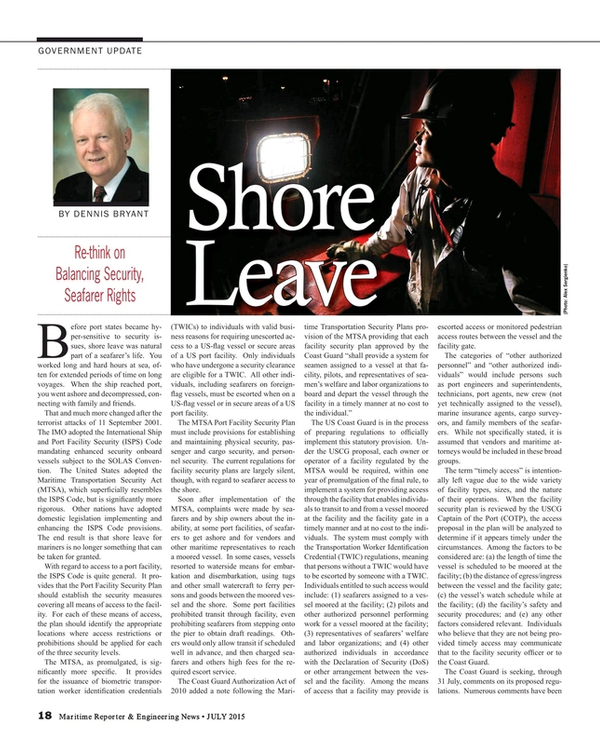
Shore Leave: Re-think on Balancing Security, Seafarer Rights
Before port states became hyper-sensitive to security issues, shore leave was natural part of a seafarer’s life. You worked long and hard hours at sea, often for extended periods of time on long voyages. When the ship reached port, you went ashore and decompressed, connecting with family and friends.
That and much more changed after the terrorist attacks of 11 September 2001. The IMO adopted the International Ship and Port Facility Security (ISPS) Code mandating enhanced security onboard vessels subject to the SOLAS Convention. The United States adopted the Maritime Transportation Security Act (MTSA), which superficially resembles the ISPS Code, but is significantly more rigorous. Other nations have adopted domestic legislation implementing and enhancing the ISPS Code provisions. The end result is that shore leave for mariners is no longer something that can be taken for granted.
With regard to access to a port facility, the ISPS Code is quite general. It provides that the Port Facility Security Plan should establish the security measures covering all means of access to the facility. For each of these means of access, the plan should identify the appropriate locations where access restrictions or prohibitions should be applied for each of the three security levels.
The MTSA, as promulgated, is significantly more specific. It provides for the issuance of biometric transportation worker identification credentials (TWICs) to individuals with valid business reasons for requiring unescorted access to a US-flag vessel or secure areas of a US port facility. Only individuals who have undergone a security clearance are eligible for a TWIC. All other individuals, including seafarers on foreign-flag vessels, must be escorted when on a US-flag vessel or in secure areas of a US port facility.
The MTSA Port Facility Security Plan must include provisions for establishing and maintaining physical security, passenger and cargo security, and personnel security. The current regulations for facility security plans are largely silent, though, with regard to seafarer access to the shore.
Soon after implementation of the MTSA, complaints were made by seafarers and by ship owners about the inability, at some port facilities, of seafarers to get ashore and for vendors and other maritime representatives to reach a moored vessel. In some cases, vessels resorted to waterside means for embarkation and disembarkation, using tugs and other small watercraft to ferry persons and goods between the moored vessel and the shore. Some port facilities prohibited transit through facility, even prohibiting seafarers from stepping onto the pier to obtain draft readings. Others would only allow transit if scheduled well in advance, and then charged seafarers and others high fees for the required escort service.
The Coast Guard Authorization Act of 2010 added a note following the Maritime Transportation Security Plans provision of the MTSA providing that each facility security plan approved by the Coast Guard “shall provide a system for seamen assigned to a vessel at that facility, pilots, and representatives of seamen’s welfare and labor organizations to board and depart the vessel through the facility in a timely manner at no cost to the individual.”
The US Coast Guard is in the process of preparing regulations to officially implement this statutory provision. Under the USCG proposal, each owner or operator of a facility regulated by the MTSA would be required, within one year of promulgation of the final rule, to implement a system for providing access through the facility that enables individuals to transit to and from a vessel moored at the facility and the facility gate in a timely manner and at no cost to the individuals. The system must comply with the Transportation Worker Identification Credential (TWIC) regulations, meaning that persons without a TWIC would have to be escorted by someone with a TWIC. Individuals entitled to such access would include: (1) seafarers assigned to a vessel moored at the facility; (2) pilots and other authorized personnel performing work for a vessel moored at the facility; (3) representatives of seafarers’ welfare and labor organizations; and (4) other authorized individuals in accordance with the Declaration of Security (DoS) or other arrangement between the vessel and the facility. Among the means of access that a facility may provide is escorted access or monitored pedestrian access routes between the vessel and the facility gate.
The categories of “other authorized personnel” and “other authorized individuals” would include persons such as port engineers and superintendents, technicians, port agents, new crew (not yet technically assigned to the vessel), marine insurance agents, cargo surveyors, and family members of the seafarers. While not specifically stated, it is assumed that vendors and maritime attorneys would be included in these broad groups.
The term “timely access” is intentionally left vague due to the wide variety of facility types, sizes, and the nature of their operations. When the facility security plan is reviewed by the USCG Captain of the Port (COTP), the access proposal in the plan will be analyzed to determine if it appears timely under the circumstances. Among the factors to be considered are: (a) the length of time the vessel is scheduled to be moored at the facility; (b) the distance of egress/ingress between the vessel and the facility gate; (c) the vessel’s watch schedule while at the facility; (d) the facility’s safety and security procedures; and (e) any other factors considered relevant. Individuals who believe that they are not being provided timely access may communicate that to the facility security officer or to the Coast Guard.
The Coast Guard is seeking, through 31 July, comments on its proposed regulations. Numerous comments have been submitted to date. Seafarers and seafarer representatives are strongly supportive. Facility representatives have raised a variety of concerns that deserve consideration. First, they contend that the one-year time frame for implementation of security plan changes is insufficient. Since a significant portion of the time would be consumed by USCG review of the changes, their point is valid. Secondly, they argue that transit of persons through the facility raises security and safety issues. This point is less valid. Everyone knows of the increased security and safety issues. Congress made the decision to move ahead regardless. Thirdly, there is the issue of whether a person seeking to transit the facility to visit a vessel will be permitted onboard by the vessel.
This is a good point, but one that must be worked out by the facility and the vessel, not by regulation. Fourthly, facility representatives note that the list of “authorized personnel” and “authorized individuals” in the regulation is more expansive than the group identified in the statute. The Coast Guard has broad authority to broad authority to interpret and make more specific various statutory provisions, including this one, but it should consider whether these terms need modification.
The major point raised by the facility representatives relates to the costs that will be incurred due to the regulation. They contend, probably correctly, that the costs estimated by the Coast Guard, are understated. More importantly, they contend that facilities should not be required to bear the costs. Careful reading of both the statute and the proposed regulation reveal that there is nothing to prevent the facility from passing the costs on to the vessel moored at the facility. It is recommended that facilities work with vessel owners and operators to allocate these added costs in an agreeable manner. In this regard, it should be noted that these transits of the facility are for the ultimate benefit the vessel, not the facility. For those facilities with official tariffs, changes to those tariffs may be necessary.
The bottom line here is that vessels moored at facilities in the United States should not be held in the equivalent of solitary confinement. Reasonable access of crew members to well-deserved shore leave must be guaranteed. Likewise, reasonable access of third parties to the vessel is also important. Providing such reasonable access is a component of the services expected of the facilities, just like their provision of services related to the cargo carried by the vessels. These regulations are long overdue and, with minor modifications, should be promulgated as soon as possible.
The Author
Dennis L. Bryant is with Maritime Regulatory Consulting, and a regular contributor to Maritime Reporter & Engineering News as well as online at MaritimeProfessional.com.
t: 1 352 692 5493
e: [email protected]
(As published in the July 2015 edition of Marine Technology Reporter - http://www.marinetechnologynews.com/Magazine)
Read Shore Leave: Re-think on Balancing Security, Seafarer Rights in Pdf, Flash or Html5 edition of July 2015 Maritime Reporter
Other stories from July 2015 issue
Content
- DNV GL: ‘Big Data’ Evolving Fast; LNG Slower than Expected page: 10
- Fuel Efficiency: The Way Forward page: 12
- Preventing Loss of Propulsion After Fuel Switch to Low Sulfur Distillate Fuel page: 14
- How to Defend against Patent Trolls without Breaking the Bank page: 16
- Shore Leave: Re-think on Balancing Security, Seafarer Rights page: 18
- “FS3” Motion-based Simulator for Dutch Navy page: 20
- Big Data: Big Value or Big Risk? page: 21
- Björn Rosengren: Power Boss (Part II) page: 22
- The Maritime Launch of Big Data page: 26
- Building Out on Big Data page: 30
- Maritime & Shipbuilding Italian Style page: 32
- Two-Stroke DF Engine Passes Critical Test page: 34
- The 'Hour of Power': Hybrid Marine Technology & Green Ports page: 35
- Specialty Motors Keep Shipping Afloat page: 36
- HYPACK Barge Management System page: 37
- Simrad Launches New Pro Line Products page: 38
- Pneumatic Band Saw page: 40
- Portable Hydraulic Drills page: 40
- Verotec’s VMEbus Systems page: 40
- Silvagrip page: 40
- Protea Heavy Lift Cranes page: 40
- Senesco Invests in New Welding System page: 40
- PYPLOK: An Alternative to Welding page: 40
- Ballast Water Compliance Tools page: 41
- Tero Marine Wins Boa Contract page: 41
- MarineNav Rack Mount Computers Range page: 41
- New Transas Pilot PRO page: 41
- Coxreels Debuts New Reel Design with 1600 Series page: 41
- Lowrance Announces Software Updates page: 41
- Almarin: 85 Years Strong page: 47


